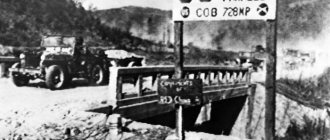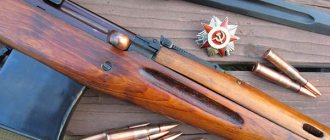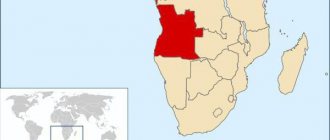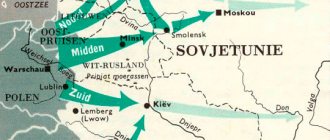The situation on the eve of the war
The Nazis, led by Hitler, after coming to power in Germany, headed for the abolition of the articles of the Treaty of Versailles. With the connivance of the governments of Great Britain and France, Germany occupied Austria by 1939 and partitioned Czechoslovakia, significantly increasing its military and industrial potential.
Seeing the aggressiveness of the Third Reich, in the spring of 1939
The Soviet Union proposed to the Western powers to sign a trilateral treaty of mutual assistance between the USSR, France and Great Britain, but was actually refused.
Then the USSR moved towards rapprochement with Germany, and on August 23, 1939
In 2010, a non-aggression pact was signed between the Soviet Union and Germany for a period of 10 years, known as
the Molotov-Ribbentrop Pact
.
The treaty also included a secret protocol that stipulated the division of spheres of influence between countries in Eastern Europe. This treaty gave Hitler a free hand for a new war in Europe.
September 1, 1939
Germany attacked Poland, and on September 3, fulfilling allied obligations, France and Great Britain declared war on Germany. The Second World War began. By September 17, German troops defeated the main forces of the Polish army. On the same day, Soviet troops, according to a clause in the secret protocol, crossed the Soviet-Polish border and occupied the territories of Western Belarus and Ukraine under the pretext of protecting fraternal peoples. Poland's Western allies made no significant offensive attempts on the Western Front.
Polish Wehrmacht campaign / Photo: ursa-tm.ru
November 30, 1939
The Soviet Union declared war on Finland after its refusal to exchange part of the Karelian Isthmus for a much larger part of Karelia. Only by March 1940, after significant losses, parts of the Red Army were able to break through the well-fortified Mannerheim Line, and Finland sued for peace. The unsuccessful actions of the Red Army in this war strengthened the opinion of the German command in the weakness of the Soviet Union.
Soviet-Finnish War: Photo: mtdata.ru
In April 1940
Germany occupied Denmark and Norway, and on May 10 invaded France through the Low Countries and within a month and a half defeated the French army and brought it out of the war.
No one expected such a turn of events. It was assumed that the war on the Western Front would take on a positional character, as during the First World War.
French campaign of the Wehrmacht / Photo: map-site.narod.ru
Summer 1940
With the active participation of the Soviet Union, elections were held in Lithuania, Latvia and Estonia. The victorious pro-Soviet forces proclaimed the creation of socialist republics, and in August the latter were accepted into the USSR.
Also in June 1940
, relying on a clause in the secret protocol, the USSR put forward an ultimatum to Romania to transfer Bessarabia and Northern Bukovina to it. After the introduction of units of the Red Army into these lands, the Moldavian SSR was formed.
Spring 1941
years, with the assistance of the troops of its allies, Germany occupied Yugoslavia and Greece. After the end of the Balkan campaign, Germany began secretly transferring its troops to the western borders of the Soviet Union.
By June 1941
Almost all of continental Europe came under the control of Hitler's Germany. Having refused the proposed truce, only Great Britain continued the war against the Third Reich.
Map of Europe by June 22, 1941 / Photo: aagokeh.xn
From Merkulov's bins
On March 11, 1944, at a time when Kiev had already been liberated by the Red Army, and the liberation of other regions of the Ukrainian SSR was actively being prepared and was a matter of the near future, People's Commissar of State Security of the USSR Vsevolod Nikolaevich Merkulov sent an important document to Stalin with the following accompanying note : “At the same time, the NKGB of the USSR presents a photocopy and translation of the “Directive for the orientation of employees” issued by the Imperial Commissioner of Ukraine.
This directive was sent out on June 22, 1942 by the head of the SS and the head of the police of Ukraine to the heads of the SS and police heads of a number of Ukrainian regions. The document was discovered by the NKGB in Kyiv"1. The directive came from the supreme leader of the SS and police under the Reich Commissioner of Ukraine, Hans Adolf Prützmann2. The document was signed for him by the chief of staff, security police colonel Müller-Brunkhorst. The paper was sent to “the leaders of the SS and police in Brest - Zhitomir - Kyiv - Nikolaev - Dnepropetrovsk - Chernigov - Kharkov”3.
The reason for writing the paper was one sad circumstance for the Germans: it turns out that “employees of the Reich Commissioner and subordinate authorities often find themselves in a difficult situation when Ukrainians ask them certain and, in most cases, specific questions. As can be seen from experience, these questions always concern the same areas and are answered below in a certain order.”4
Causes of the Great Patriotic War
The main reason for the outbreak of the Great Patriotic War was the expansionism of the Third Reich and its desire for world domination. Hitler has repeatedly stated that his main enemy is the Soviet Union.
In his election slogans, the Fuhrer proclaimed the need to expand the living space of the German nation to the East, which implied the occupation primarily of Ukraine and southern Russia.
In the early 1930s
During the struggle for power, the main opponents of the Nazis were the communists. Hitler never hid his anti-communist and anti-Bolshevik views. The non-aggression pact with the Soviet Union was signed only in order not to repeat the mistake made by Germany in the First World War and not to fight on two fronts simultaneously.
Due to the failure of the German air force to achieve air superiority during the Battle of Britain, Operation Sea Lion, the invasion of the British Isles, was postponed. The German command considered it too risky to carry out an amphibious operation without having an advantage in the air and at sea.
After the USSR refused to join the Tripartite Pact of Germany, Italy and Japan in 1940, the German command began developing a war plan against the Soviet Union, called Barbarossa.
.
Plan "Barbarossa" / Photo: worldmilitary.net
Plan Barbarossa
meant "blitzkrieg" - lightning warfare, which Germany successfully tested during the Polish and French campaigns. Moreover, the Wehrmacht gained extensive experience in warfare in modern conditions, and the war of the Soviet Union against Finland showed the weakness of the Red Army.
Stages of the Great Patriotic War
The first stage of the war (June 22, 1941 - November 18, 1942)
At the beginning of the war, Germany did not have an advantage in the number of personnel and weapons, but was able to concentrate superior forces in the main sectors of the offensive.
Plan Barbarossa called for an attack on the Soviet Union by three army groups: Army Group North
was supposed to occupy the Baltic states and Leningrad,
Army Group "Center"
was advancing through Belarus to Moscow,
Army Group "South"
was supposed to capture Kiev and Donbass.
According to the plan, the war was supposed to end by the winter of 1941 with the entry of German troops to the Arkhangelsk-Volga line.
On the morning of June 22, 1941
Germany, violating the non-aggression pact, attacked the USSR. At 12 noon on June 22, the People's Commissar for Foreign Affairs of the USSR Vyacheslav Mikhailovich Molotov announced this to the Soviet people on the radio.
Muscovites listen to Molotov's address / Photo: russian7.ru
In the first hours of the war, the German Luftwaffe attacked Soviet airfields, railway junctions, and troop concentration areas. A large number of Soviet aircraft were destroyed while still on the ground. Soviet troops offered stubborn resistance to the invaders, but Wehrmacht units quickly advanced deep into the territory of the Soviet Union, surrounding tens of thousands of soldiers and officers of the Red Army with tank wedges.
On June 23, the Soviet leadership created the Headquarters of the Supreme High Command for strategic control of troops. A large-scale mobilization was announced, rear work was organized, and a plan was prepared for the evacuation of industrial enterprises to the Urals, Volga region, Siberia and Central Asia.
Despite all the efforts made, Wehrmacht units took Minsk on June 28, surrounded Leningrad on September 8, entered Kyiv on September 19, and by the end of September reached the approaches to Moscow.
By the winter of 1941
Soviet troops suffered colossal losses - over 5 million people; The Baltic states, Belarus, most of Ukraine and a significant part of the European part of Russia were abandoned. Many important industrial centers and food sources were lost.
Germans near Moscow / Photo: yandex.net
Having exhausted the enemy in defensive battles, on December 5, 1941, the Red Army launched a counteroffensive with the forces of three fronts and pushed back German troops 100–250 km from the capital.
The heroic defense of many cities and the victory near Moscow thwarted Hitler’s plans for a “blitzkrieg” and a quick end to the war.
In the protracted war of attrition, the Soviet Union received significant assistance from the American Lend-Lease program, under which military equipment, ammunition, food, raw materials, etc. were supplied to the USSR.
After the victory near Moscow, the Soviet leadership undertook a series of offensive operations with the goal of quickly defeating the enemy and expelling him from the country. Being insufficiently developed and lacking the necessary resources, they all failed.
The Kharkov operation in May 1942 turned into a real disaster, during which hundreds of thousands of Soviet soldiers were surrounded and destroyed. After this defeat of the Red Army, the road to the Volga and the Caucasus was opened for the Germans.
Counteroffensive near Moscow / Photo: infourok.ru
Counteroffensive near Moscow / Photo: yandex.ru
Summer 1942
, not having the strength to attack along the entire front line, the German command made the main attack on the southern sector of the front. The main goal was to seize the main sources of food in the Don and Kuban, as well as to capture the oil fields of the Caucasus.
By the end of July, under the pressure of the Germans, Soviet troops were forced to retreat beyond the Don, and by the end of August the enemy approached Stalingrad. During the autumn there were fierce battles in the city. Stalingrad was almost completely destroyed by German aircraft, artillery and fires.
The situation at the front by November 1942 / Photo: armedman.ru
Fighting in Stalingrad / Photo waralbum.ru
Despite Hitler's demand to take Stalingrad at any cost, by November 1942 the German offensive had run out of steam.
Second stage of the war (November 19, 1942 - December 1943)
On November 19, 1942, having accumulated enough forces and reserves, Soviet troops launched a counteroffensive and four days later surrounded the 6th German Army of Field Marshal Friedrich Paulus, which was storming Stalingrad. Over 300 thousand enemy soldiers and officers were surrounded.
All attempts to supply those surrounded by air, as well as to release them from the outside, failed, so on February 2, 1943
the remaining German troops surrendered.
Over 90 thousand enemy soldiers were captured, as well as 24 generals and a field marshal. The Wehrmacht troops had never known such a defeat.
The Battle of Stalingrad is considered a turning point in the war. After the victory at Stalingrad, the strategic initiative passed to the Red Army.
Encirclement of the Germans at Stalingrad / Photo: ya-znau.ru
German prisoners at Stalingrad / Photo: ya-znau.ru
In January 1943
The blockade of Leningrad was partially broken, and in the Caucasus direction German troops were forced to retreat, trying to avoid encirclement.
Summer 1943
The German command launched the last attempt at a large-scale offensive in the war.
The Germans launched an attack in the Kursk Bulge
, using a large number of tanks, including the new Tigers and Panthers.
This was the largest battle in the entire previous period of the war, lasting from July 5 to August 23. Soviet troops repulsed all enemy attempts to break through the front and launched a counteroffensive.
As a result, Orel, Belgorod and Kharkov were liberated. In honor of the end of the Battle of Kursk, fireworks went off in Moscow for the first time during the war.
Battle of Kursk / Photo: munvnukovo.ru
Battle of Kursk / Photo: munvnukovo.ru
Building on their success, Soviet troops during the autumn of 1943
liberated almost the entire left bank of Ukraine and crossed the Dnieper in many places. The German command's hope that the Dnieper would become a long-term line of defense failed. On November 6, Kyiv was liberated.
Crossing of the Dnieper / Photo: news-front.info
From November 28 to December 1, 1943,
in Tehran
between the leaders of the USSR, the USA and Great Britain.
At this conference, agreements were reached between Joseph Stalin, Franklin Delano Roosevelt and Winston Churchill on the opening of a second front
in Europe and the post-war world order.
Tehran conference / Photo: yandex.net
The third stage of the war (January 1944 - May 9, 1945)
In December 1943
In 1944, a series of offensive operations began to liberate right-bank Ukraine, ending in April 1944 with the withdrawal of Soviet troops to the state border of the Soviet Union and Romania.
From April 8 to May 12,
the Red Army carried out a campaign to liberate Crimea, which ended with the complete elimination of the enemy on the peninsula.
In January 1944
Soviet troops began an operation with the goal of finally lifting
the siege of Leningrad
. On January 27, artillery salvoes were fired, marking the end of the blockade, which lasted 872 days and claimed hundreds of thousands of civilian lives.
Lifting the blockade of Leningrad / Photo: lokkprf.ru
June 6, 1944
Allied troops landed in Normandy during Operation Overlord.
A second front
was opened in Europe .
In June 1944, the Red Army began an operation to liberate Belarus, called “Bagration”.
By the beginning of autumn
Soviet troops defeated the German Army Group Center and reached the borders of Poland.
Operation Bagration / Photo: twimg.com
Autumn 1944
Almost the entire Baltic region was liberated from German invaders.
Against the backdrop of a series of victories by the Red Army and the retreat of the Wehrmacht troops, its allies began to break away from Germany, and anti-Nazi uprisings broke out in satellite countries. Romania and Bulgaria were the first to declare war on their former ally.
Having replenished reserves and regrouped troops, in January 1945
Soviet troops launched an offensive along the entire front. By April, the territories of Poland, Hungary, Austria, and Czechoslovakia were liberated from the Wehrmacht troops.
The final stage of the war / Photo: yandex.net
April 16, 1945
Soviet troops began the Berlin operation, and on May 2 the Berlin garrison surrendered.
Victory Banner over the Reichstag / Photo: yandex.net
May 8, 1945
Germany signed the Act of Unconditional Surrender. The Great Patriotic War has ended.
Signing of the act of surrender of Germany / Photo: yandex.net
1942-06-28-Voronezh-Voroshilovgrad strategic defensive operation
June 28 - July 24, 1942
See maps
1942-06-28-Voronezh-Voroshilovgrad defensive operation
War Statistics - Strategic Operations
It was carried out with the aim of repelling the enemy’s offensive in the Voronezh and Voroshilovgrad directions. The troops of the Bryansk (part of the forces), Voronezh, South-Western, Southern fronts defended themselves with the participation of the Don detachment of the Azov military flotilla.
During the fighting, the Soviet troops additionally included the administration of the Voronezh Front, the administration of three armies, four tank corps and twenty divisions.
As part of the Voronezh-Voroshilovgrad strategic defensive operation, the Kastornenskaya, Valuysko-Rossoshanskaya and Voroshilovgradsko-Shakhtinskaya frontal defensive operations were carried out.
Duration - 27 days. The width of the combat front is 900 km. The depth of withdrawal of Soviet troops is 150-400 km.
Composition of the opposing sides' troops
The German Army Group South included the 6th and 17th Armies and the 1st Panzer Army, as well as the Weichs Army Group (2nd Army, 4th Panzer Army, 2nd Hungarian Army). The entire group was covered by the 4th Air Fleet.
Soviet troops, after heavy May and June battles, defended themselves:
- on the Bryansk Front (commanded by Lieutenant General F.I. Golikov) in a 350-km zone from Belyov to the upper reaches of the Seim River - 3rd, 48th, 13th and 40th Armies, 2nd Air Army;
- on the Southwestern Front (commander Marshal of the Soviet Union
S.K. Timoshenko) in a 300-km zone from the upper reaches of the Seim to Krasny Liman (southeast of Izyum) - 21st, 28th, 38th, 9th and 57th armies, 8th air army;
- on the Southern Front (commanded by Lieutenant General R.Ya. Malinovsky) in a 250-km zone from Krasny Liman to Taganrog Bay (east of Taganrog) - 37th, 12th, 18th, 56th and 24th air army.
Progress of the operation
By the beginning of the enemy’s offensive, Soviet troops did not have time to make up for the losses suffered in previous battles, gain a foothold on occupied lines and create a strong defense.
The fascist German command, having seized the strategic initiative in the spring of 1942, prepared a summer general offensive in the south with the goal of defeating the opposing Soviet troops and capturing the Caucasus.
On June 28, the Weichs army group from the area northeast of Kursk launched an offensive in the Voronezh direction and broke through the defenses of the Bryansk Front troops. The Supreme High Command headquarters reinforced the Bryansk Front with three tank corps, fighter and attack aircraft and ordered a counterattack to stop the enemy's advance.
However, the plan of the Headquarters was not realized. On June 30, the 6th German Army went on the offensive from the Volchansk region in the Southwestern Front and broke through its defenses.
By the end of July 2, the enemy advanced in the Bryansk Front to a depth of 60-80 km and in the Southwestern Front to 80 km, encircling part of the forces of the 40th and 21st armies west of Stary Oskol.
The Supreme High Command headquarters sent the 3rd, 6th and 5th reserve armies to the Voronezh direction, renaming them respectively the 60th, 6th and 63rd armies. At the same time, on her instructions, the 5th Tank Army, reinforced by the 7th Tank Corps, was concentrated in the Yelets area to launch a counterattack against the wedged enemy. The 1st Fighter Aviation Army of the Headquarters reserve was also redeployed there.
On July 6, the enemy crossed the Don River and captured most of Voronezh. On the same day, the 5th Tank Army launched a counterattack south of Yelets against the troops of the left flank of the Weichs army group, to repel which the enemy was forced to attract the 24th Tank Corps, three infantry divisions and the 4th Tank Army.
In order to prevent the encirclement of Soviet troops south of Voronezh, with the permission of Headquarters, on the night of July 7, they were withdrawn to new lines. At the same time, in order to better manage the troops on the southern wing, the Bryansk Front was divided into two fronts: Bryansk (acting commander Lieutenant General N.E.
Chibisov) - 3rd, 48th, 13th armies, 5th tank army, 1st and 16th tank and 8th cavalry corps, front and Voronezh aviation (commanded by Lieutenant General F.I. Golikov, from July 14 - Lieutenant General N.F.
Vatutin) - 60th, 40th, and 6th Armies, 4th, 17th, 18th and 24th Tank Corps, 2nd Air Army.
By July 7, the enemy expanded the breakthrough to 300 km along the front and deeply enveloped the troops of the Southwestern Front from the north, trying to encircle them, but they managed to retreat. The enemy also failed to encircle the troops of the Southern Front defending in the Donbass.
Combat strength, number of Soviet troops and casualties
Name of formations and terms of their participation in the operation
Combat composition and number of troops at the beginning of the operation Human losses in the operation
number of formations
number of non-return sanitary total average daily
Bryansk Front - 13th, 40th armies, 5th tank army (all period) sd - 12, sbr - 4, tk - 2, otbr - 4 169400 36883 29329 66212 2452
Southwestern Front (28.06.-12.07.42) sd - 33, cd - 6, tk - 4, sbr - 6, msbr - 3, detachment - 10, ur - 5 610000 161465 71276 232741 15516
Southern Front (entire period) sd-23, sbr - 4, tbr - 6, UR - 1 522500 128460 64753 193213 7156
Voronezh Front (07/9-24/42) — — 43687 32442 76129 4758
Azov Military Flotilla (Don Detachment) - 8900 27 25 52 2
Total
Divisions - 74, TK - 6, Br - 37, UR-6 1310800 37052228.3% 197825 568347 21050
Results of the operation
The fighting in this operation took place in conditions when the troops of the Bryansk, Southwestern and Southern Fronts, having not recovered their strength after previous heavy battles and not having had time to gain a foothold in the defense, were forced to repel attacks from superior enemy forces.
They were unable to hold their defended positions and, with heavy losses, retreated to the Voronezh region and the river. Don. The 6th and 60th armies brought into the battle from the reserve of the Supreme High Command Headquarters and the counterattack of the 5th Tank Army on the enemy’s northern grouping weakened its onslaught, but did not change the overall development of the situation.
The enemy managed to develop a further attack on Rostov and Stalingrad.
Home front during the Great Patriotic War
From the very beginning of the war, the Soviet leadership began to take steps to transfer the economy to a “war footing.” The production of goods for civilian needs was reduced in favor of the army. The Soviet Union experienced great difficulties because the Germans occupied the most densely populated regions, which were also centers of industry and agriculture. Due to the enemy's advance beyond the Urals, millions of people and hundreds of industrial enterprises were evacuated.
Evacuation of industry / Photo: bagira.guru
Despite all the difficulties, by mid-1942
The output of military products exceeded pre-war indicators, the army received everything it needed in full.
Separately, it is worth noting the heroism of Soviet citizens who worked at enterprises with virtually no rest. Instead of the men who had gone to the front, the places at the machines were taken by women and teenagers.
Teenagers at the factory / Photo: yandex.net
“Everything for the front, everything for victory” became popular.
with whom people spared nothing, giving up their savings and property for the needs of the front.
During the war, cultural life did not come to a standstill: artists gave thousands of concerts in troops and hospitals, musical works and poems were written, and films were made.
Concert among the troops during the war / Photo: kulturaufa.ru
“The workers go to Germany cheerful and singing...”
The directive begins with a general statement, the main motive of which is that Ukrainians with their culture should be brushed aside with all their German bureaucratic training and beautifully told about life and work in Germany. Propaganda slogans are combined in this setting with an emphasized disdain for the occupied population: “It is in the interests of every Ukrainian to help in his own way to ensure that this war ends victoriously for the liberator of Ukraine from the Bolshevik yoke. When we make a decision, the question always at the forefront of our minds is whether this matter is decisive or important in a military sense. We can worry about things that are neither decisive nor important for the war only as a secondary concern, and now, as a rule, we can not think about them at all. With this we answer in advance many questions from Ukrainians about why we don’t organize or do this or that. So, for example, at the moment we have other concerns than thinking about the development of Ukrainian literature; We can only keep this in mind.”5
The following are answers to the most sensitive questions for occupation officials. There are exactly six of these problems, four of them are especially noteworthy:
“a) What geographical and state form will Ukraine take in the future?
Answer: Only the Fuhrer will give the final answer to these questions. There is no doubt that the Fuhrer will not make a decision until the end of the Eastern campaign; it is very likely that he will make a decision only after the end of the war.
b) What are the German authorities doing to develop Ukrainian culture?
Answer: In general terms, the answer to this question has already been given in the introduction. However, creating the prerequisites for the restoration of Ukrainian culture was not the immediate goal of our soldiers’ struggle. Now it is important to create the preconditions for victory in the field of food and agriculture through joint efforts. This should not mean that we are trying to bring Ukraine into a state of lack of culture or that we want to oppress the cultural institutions of Ukrainians. We do not prevent Ukrainians from staging Ukrainian plays in existing Ukrainian theaters with the forces still at their disposal. We give them the opportunity to watch films in their cinemas again. We favor Ukrainian national attire and Ukrainian folk songs. As soon as the war ends and there is again enough paper, it will be possible to republish old or create new Ukrainian literature. The fact that we have confiscated the radios and are not yet giving them back is explained by the following: the war is waged not only with firearms, but also with spiritual weapons. Just as the rear areas must be protected from enemy fire, in the same way the population in the rear must be protected from the effects of enemy propaganda. It is absolutely established that a significant percentage of Ukrainians, Russians and Poles disseminate enemy propaganda and thereby cause unrest and disorder. […]
e) How will the food situation develop?
Answer: The rural population of Ukraine is sufficiently supplied with food. In addition, in greater or lesser proximity to cities, it achieved unprecedented prosperity. It is not our fault that the urban population cannot be sufficiently supplied with food. We are, of course, doing everything we can to eliminate this evil, especially in relation to those who work. Since the Bolsheviks destroyed means of transport and, in addition, many agricultural means of production, one cannot count on a radical change in this situation in the near future. However, these complaints are often exaggerated. Not a single Ukrainian has ever died of hunger.
f) How are Ukrainians recruited for Germany used?
Answer: There are rumors that Ukrainians recruited for Germany are allegedly used at the front for earthworks and similar purposes. The spread of these rumors has already deterred many volunteers. Not a single Ukrainian who signed up to work in the Empire has so far been used otherwise than to work in the Empire. Workers go to Germany cheerful and singing, and are eager to get acquainted with German living conditions.”6
Women in the Great Patriotic War
From the very first days of the war, thousands of women began to sign up as volunteers to be sent to the front. In total, up to a million women fought with the enemy during the war years. There were over a thousand female snipers in the Red Army, who killed more than 11,280 enemy soldiers and officers.
Women's sniper squad / Photo: kulturaufa.ru
Separate women's formations were created: aviation regiments, air defense regiments, rifle units.
“Night Witches” / Photo: yandex.net
The entire burden of providing the country with food fell on women's shoulders; about 19 million women worked in agriculture. Hundreds of thousands of women replaced men in factories.
Almost 2 million female doctors fought for the lives of Red Army soldiers, many of whom were awarded awards for their courage and heroism, including the title of Hero of the Soviet Union.
Nurse on the battlefield / Photo: yandex.net
Results of the Great Patriotic War
The Great Patriotic War ended with the complete defeat of Germany and its allies. The USSR not only defended its independence, but also liberated the countries of Eastern and Central Europe from Nazism.
The Soviet Union made the greatest contribution to the victory over Nazism, destroying over 80% of enemy soldiers and officers and 75% of the total military equipment on the Eastern Front. As a result of the war, the USSR became one of the two leading world powers along with the United States.
But the victory was very difficult for the Soviet people. Over 27 million people died, thousands of cities and tens of thousands of villages were destroyed. Most of the infrastructure in the territories captured by the Germans was destroyed: enterprises, bridges, railways. Agriculture, especially livestock farming, also suffered heavy losses. The Soviet Union lost over 30% of its national wealth.
75 years of Victory | Let's remind Europe about the real victors of Nazism
Basic Concepts
- Blitzkrieg is a theory of waging a fleeting war, the essence of which is to achieve complete victory over the enemy in the shortest possible time - from several days to several months. The key to the success of this theory is that the enemy does not have time to mobilize and deploy the main military forces.
- The State Defense Committee (GKO) is an emergency governing body that existed during the Great Patriotic War. He was endowed with full military, political and economic power. The head of the State Defense Committee was I. Stalin.
- Blockade is an action by one of the parties to a military conflict, the purpose of which is to comprehensively isolate an enemy target by preventing the transfer of military reinforcements to it, the delivery of military equipment and logistics, and the evacuation of valuables.
- Order No. 227 (“Not a step back!”) - this order, signed personally by I. Stalin, prohibited retreat without a special order from the command and provided for the formation of penal units, into which those convicted of violating military discipline could end up. Thus, penal battalions and companies appeared at the front, as well as barrage detachments formed from NKVD employees, designed to maintain military discipline and suppress attempts at desertion of military personnel.
- The Anti-Hitler Coalition is a military-political alliance of states that acted in World War II against the aggressor countries (Germany, Japan, Italy and their satellites). Although by the end of the war the coalition consisted of more than 50 states, the USSR, Great Britain and the USA played key roles in it.
- Lend-Lease is a US government program that provided for the supply of ammunition, equipment, food and strategic raw materials to the allies of the anti-Hitler coalition.










